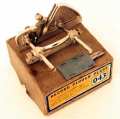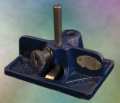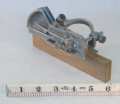#043 Tiny Plough Plane
This is by far the smallest plough plane I know of. However, it wasn't unique to Record. Versions of this design were made by the Rapier and Marples companies (among others). There is also a variation with a single fence rod (the Record #040). See the discussion under the #778 to find out why you wouldn't want it.It was essentially designed for grooving in drawer and box bottoms; it was only supplied with 3 blades (1/8", 3/16", 1/4") but metric blades (4mm, 6mm, 9mm, 12mm) for "European" plywood were available as extras. You can put almost a blade from virtually any other combination type plane in this little toy - there is no depth of cut adjustment, and the blade clamp is a lever cap, so there are no notches, slots or divots on the blade. The blades do taper a little, front to back, to give clearance in the groove being cut. Most plough plane blades have this feature, if you examine them closely. More on the blade clamp a little later.
The tool can cut grooves up to 4" from the edge, and up to 1/2" deep. You probably wouldn't want to use it anywhere near these limits. The fence isn't really big enough. In fact, for the uses I find it best for, I've considered sawing 2" off the fence rods - they're too long.
Since the commonest use for a #043 is grooving in bottoms (or tops), the maximum capacity required is the thickness of your top/bottom stock; say 3/4". Allowing for my 1/2" auxillary wooden fence (very nice), I cut 2.6" rods from the steel. The result is every bit as nice as I'd hoped (see earlier paragraph) and I haven't taken a hacksaw to vintage iron.

#044 Small Plough Plane
This tool is a good deal larger than the #043, and has (yippee!) a depth of cut adjuster. Although its theoretical capacity is not that much greater (5" from edge, up to 9/16" cutter) the overall size of the tool, (especially the fence) and the excellent balance means that larger work can be tackled with confidence. The cutters supplied as standard run from 1/8" up to 9/16" in 1/16" increments (8 cutters). The #044 comes with short rods as well as long rods (see #043) which saves making them...The #044 is slightly smaller than a #050, and a good deal lighter. Many people use it as their ploughing tool of choice, using heavier, more versatile planes (#50, #405 (Stanley #45-a-like) or #55) only when they must.
Oh damn, the blade clamp's missing!
Most combination planes tend to lose parts that aren't permanently attached, or in the box. With many planes this isn't a big deal, you just end up with a few less options. But on the #043 and #044 the blade clamp is separate. If the screw loosens a little, the blade clamp (and blade) can become completely detached from the plane. On its meandering course from the Record factory to the workshop of a true rust-hunter this temporary separation may become permanent, leaving the annoying situation of an otherwise good plane, unusable because of a small missing piece.
However, all is not lost. Having performed a few experiments, I can tell you that the blade clamps of the #043 and #044 are interchangeable. So if you buy both, you can get away with one of them missing a blade clamp - this may be to your financial advantage.
However, if you have some metalworking ability, and a few hours to spare you may find these drawings(PDF, 41Kb) useful.
The blade clamp is essentially a screw lever cap; the front foot is pressed firmly down by tightening the rear screw. The pivot is actually a large, square casting on the body of the plane.
(Picture from Bob Brode's site, with permission - thanks, Bob!)

#050 Light combination plane
In truth this is almost a clone of the earlier Stanley #50, but the Record has a superior blade depth adjuster (inline screw, instead of that nasty lever) and slightly larger capacity, so I thought I'd mention the differences here.
#T5 Technical/Shooting Jack
This was a #5 variation, with changes to make it easier to use on a shooting board. The cheeks of the body were much larger, to give more stability when used on its side, and there was a little side handle (which almost always gets lost). It didn't sell in great numbers, and is consequently quite rare (and consequently sought after).A passing reference to the T5 in the context of other, even rarer and more expensive planes designed for shooting boards

#073 Mondo Shoulder Plane
The 3 chapter history of this plane went: Preston, then Record, and now Lie-Nielsen.Despite its self evident large size and weight, many people find this the best shoulder plane to use, even on smallish tenons. Don't ask me why, that's what they say.
(some people have pointed out that Preston, and subsequently Record have a wide range of unique shoulder planes; I may get round to the rest one day.)

#311 Convertible Shoulder Plane
In common with the #073 it has gone through 3 companies. The #311 was invented by Preston, then made by Record, then adopted by a niche company, in this case Clico Tooling, under their "Clifton" brand. Hence the current Clifton #3110.#722 Router Plane
A truly wonderful small tool, superior to the common Stanley #271, and a design derived very closely from the Preston #22. The genius is in the way a single draw-bolt holds the blade in position in both positions (open and closed mouth). The draw bolt passes diagonally through the casting, and would foul both blade holes, but for the bolt being nicely recessed to allow the blade passage. The tension of the knurled nut pulling on the draw-bolt tries to pull the bolt past the recess (but can't, of course) thus providing the required holding force. The Stanley design requires the thumbscrew to be laboriously removed and refixed when switching blade positions, and also means the thumbscrew is mating against threads in cast iron, whereas both male and female threads in the #722 design are steel.

#778 Twin Railed Duplex Rebate Plane
I'm happy to say that this superior plane is still made by Record. The advantage over all other manufacturers' #78 versions is the double rail.When a #78 is used in "sash fillister" mode, i.e. the fence far away on the opposite side of the workpiece to the rebate being cut (as illustrated), the fence is able to spin on the single rod that holds it. Many #78 fence retaining screws bear the signs of users trying (in vain) to apply sufficient tension to stop this. Of course, all plough planes (that I know of) use twin fence rods to avoid this. But only Record (O.K. and "Woden") applied this idea to metal rebate planes.
It appears there may have been a linear inheritance of the "2 railed rebate plane design". Following a sighting of a 2 railed rebate #A78 by WS of Birmingham on Ebay, a conversation with some fellow fans led to the following facts being assembled:
- Steel Nut & Joseph Hampton's catalogue #52, 1951 lists no planes under their "Woden" brand
- Steel Nut & Joseph Hampton bought WS in 1952
- The Woden W.78 Improved Rabbet plane is introduced in November 1953. Both the WS and Woden planes have a front knob
- Steel Nut & Joseph Hampton form a wholly owned subsidiary company "Woden Ltd", 1957
- Record's price lists for 1957 doesn't show the #778, but the list of 1959 does
- Record buy Woden April 1964

#2506 Side rebate Plane
Another Preston design inheritance. I shan't say much, since the Museum of Woodworking Tools has a detailed article. At one time the 2506s was a 2506 with added depth stop, but it appears that later the depth step became included into the "plain" 2506.



